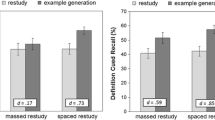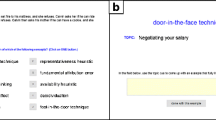Abstract
Declarative concepts (i.e., key terms with short definitions of the abstract concepts denoted by those terms) are a common kind of information that students are expected to learn in many domains. A common pedagogical approach for supporting learning of declarative concepts involves presenting students with concrete examples that illustrate how the abstract concepts can be instantiated in real-world situations. However, minimal prior research has examined whether illustrative examples actually enhance declarative concept learning, and the available outcomes provide weak evidence at best. In the three experiments reported here, students studied definitions of declarative concepts followed either by illustrative examples of those concepts or by additional study of the definitions. On a subsequent classification test in which learners were presented with examples and were asked to identify which concept the example illustrated, performance was greater for students who had studied illustrative examples during learning than for students who only studied definitions (ds from 0.74 to 1.67). However, the effects of illustrative examples on declarative concept learning depended in part on the conditions under which those examples were presented. Although performance was similar when examples were presented after versus before concept definitions (Experiments 1a–1b), classification accuracy depended on the extent to which examples of different concepts were interleaved and whether definitions were presented along with the examples (Experiment 2).



Similar content being viewed by others
Notes
This characteristic is also what distinguishes declarative concepts from declarative facts, which are non-abstract statements with truth values (e.g., George Washington was the first president of the USA; the capital of Ohio is Columbus).
Examples for each concept were presented in separate blocks to align the schedule of presentation trials in the example groups with the schedule of presentation trials in the definition-only group. In the definition-only group, presentation of the definition for each concept was spaced across blocks, because a wealth of prior research has shown that massed restudy often has minimal to no benefit for learning (for reviews, see Cepeda, Pashler, Vul, Wixted, and Rohrer 2006; Dunlosky et al. 2013). Thus, massed restudy would have provided a very weak comparison group.
Lower-familiarity and higher-familiarity students in each experiment did not significantly differ in age, education, or vocabulary (all ps 0.18–0.98, except for a significant 4 % difference in vocabulary and a 0.7-year difference in education favoring the higher-familiarity subset in Experiment 1a), although they may have differed on other factors not measured here. Differences in concept familiarity were related to the time of semester in which participants completed the experiment in Experiment 1a and Experiment 2, with 77 and 62 % of lower-familiarity participants completing the experiment in the first half of the semester versus only 36 and 33 % of higher-familiarity participants in the first half of the semester. Both of these experiments involved samples drawn from the Kent State participant pool, the majority of which consists of students enrolled in General Psychology (in which the relevant content domain tends not to be covered until later in the semester). In Experiment 1b, 72 and 70 % of lower-familiarity and higher-familiarity participants completed the experiment in the first half of the semester, but the Washington University participant pool includes a much large proportion of advanced undergraduates who likely had completed coursework in which they may have previously encountered the experimental concepts.
References
Allen, S. W., & Brooks, L. R. (1991). Specializing the operation of an explicit rule. Journal of Experimental Psychology: General, 120, 3–19.
Brooks, L. R., Norman, G. R., & Allen, S. W. (1991). Role of specific similarity in a medical diagnosis task. Journal of Experimental Psychology: General, 120, 278–287.
Carmines, E. G., & Zeller, R. A. (1979). Reliability and validity assessment. Thousand Oaks: Sage.
Cepeda, N. J., Pashler, H., Vul, E., Wixted, J. T., & Rohrer, D. (2006). Distributed practice in verbal recall tasks: A review and quantitative synthesis. Psychological Bulletin, 132, 354–380.
Cortina, J. M., & Nouri, H. (2000). Effect size for ANOVA designs. Thousand Oaks: Sage.
DeCaro, M. S., & Rittle-Johnson, B. (2012). Exploring mathematics problems prepares children to learn from instruction. Journal of Experimental Child Psychology, 113, 552–568.
Di Vesta, F. J., & Peverly, S. T. (1984). The effects of encoding variability, processing activity, and rule-examples sequence on the transfer of conceptual rules. Journal of Educational Psychology, 76, 108–119.
Dunlosky, J., & Metcalfe, J. (2009). Metacognition. Beverly Hills: Sage.
Dunlosky, J., Rawson, K. A., Marsh, E. J., Nathan, M. J., & Willingham, D. T. (2013). Improving students’ learning with effective learning techniques: Promising directions from cognitive and educational psychology. Psychological Science in the Public Interest, 14, 4–58.
Griffin, M. M. (1993). Do student-generated rational sets of examples facilitate concept acquisition? Journal of Experimental Education, 61, 104–115.
Hambrick, D. Z. (2003). Why are some people more knowledgeable than others? A longitudinal study of knowledge acquisition. Memory & Cognition, 31, 902–917.
Hambrick, D. Z., Meinz, E. J., Pink, J. E., Pettibone, J. C., & Oswald, F. L. (2010). Learning outside the laboratory: Ability and non-ability influences on acquiring political knowledge. Learning and Individual Differences, 20, 40–45.
Hamilton, R. (1990). The effect of elaboration on the acquisition of conceptual problem-solving skills from prose. Journal of Experimental Education, 58, 5–17.
Hestenes, D., Wells, M., & Swackhamer, G. (1992). Force concept inventory. The Physics Teacher, 30, 141–158.
Jacoby, L. L., Wahlheim, C. N., & Coane, J. H. (2010). Test-enhanced learning of natural concepts: Effects on recognition memory, classification, and metacognition. Journal of Experimental Psychology: Learning, Memory, and Cognition, 36, 1441–1451.
Judd, C. M., & McClelland, G. H. (1989). Data analysis: A model comparison approach. New York: Harcourt Brace Jovanovich.
Kalyuga, S., Rikers, R., & Paas, F. (2012). Educational implications of expertise reversal effects in learning and performance of complex cognitive and sensorimotor skills. Educational Psychology Review, 24, 313–337.
Kaminski, J. A., Sloutsky, V. M., & Heckler, A. F. (2013). The cost of concreteness: The effect of nonessential information on analogical transfer. Journal of Experimental Psychology: Applied, 19, 14–29.
Karpicke, J. D., & Blunt, J. R. (2011). Retrieval practice produces more learning than elaborative studying with concept mapping. Science, 331, 772–775.
Kintsch, W. (1998). Comprehension: A paradigm for cognition. Cambridge: Cambridge University Press.
Klausmeier, H. J., & Feldman, K. V. (1975). Effects of a definition and a varying number of examples and nonexamples on concept attainment. Journal of Educational Psychology, 67, 174–178.
Libarkin, J. (2008). Concept inventories in higher education science. National Research Council, Promising Practices in Undergraduate STEM Education Workshop 2.
Medin, D. L., & Schaffer, M. M. (1978). Context theory of classification learning. Psychological Review, 85, 207–238. 31 pgs.
Morris, C. D., Bransford, J. D., & Franks, J. J. (1977). Levels of processing versus transfer appropriate processing. Journal of Verbal Learning and Verbal Behavior, 16, 519–533.
Murphy, G. (2004). The big book of concepts. Cambridge: MIT Press.
Myers, D. G. (2010). Psychology: Ninth Edition. New York: Worth Publishers.
Needham, D. R., & Begg, I. M. (1991). Problem-oriented training promotes spontaneous analogical transfer: Memory-oriented training promotes memory for training. Memory & Cognition, 19, 543–557.
Nosofsky, R. M. (1999). Examplar-based accounts of relations between classification, recognition, and typicality. Journal of Experimental Psychology: Learning, Memory, and Cognition, 14, 700–708.
Paas, F. G. W. C., & Van Merriënboer, J. J. G. (1994). Variability of worked examples and transfer of geometrical problem-solving skills: A cognitive-load approach. Journal of Educational Psychology, 86, 122–133.
Pashler, H., & Harris, C. R. (2012). Is the replicability crisis overblown? Three arguments examined. Perspectives on Psychological Science, 7, 531–536.
Peterson, D. J., & Mulligan, N. W. (2013). The negative testing effect and multifactor account. Journal of Experimental Psychology: Learning, Memory, and Cognition, 39, 1287–1293.
Rawson, K. A., & Dunlosky, J. (2012). When is practice testing most effective for improving the durability and efficiency of student learning? Educational Psychology Review, 24, 419–435.
Reder, L. M., & Anderson, J. R. (1982). Effects of spacing and embellishment on memory for the main points of a text. Memory & Cognition, 10, 97–102.
Reed, S. K., & Bolstad, C. A. (1991). Use of examples and procedures in problem solving. Journal of Experimental Psychology: Learning, Memory, and Cognition, 17, 753–766.
Rittle-Johnson, B., & Star, J. R. (2011). The power of comparison in learning and instruction: Learning outcomes supported by different types of comparisons. In J. P. Mestre & B. H. Ross (Eds.), Psychology of learning and motivation: Cognition in education (Vol. 55, pp. 199–222). San Diego: Elsevier.
Roediger, H. L., Weldon, M. S., & Challis, B. H. (1989). Explaining dissociations between implicit and explicit measures of retention: A processing account. In H. L. Roediger III & F. I. M. Craik (Eds.), Varieties of memory and consciousness: Essays in honour of Endel Tulving (pp. 3–41). Hillsdale: Erlbaum.
Rohrer, D. (2012). Interleaving helps students distinguish among similar concepts. Educational Psychology Review, 24, 355–367.
Rosch, E., & Mervis, C. B. (1975). Family resemblances: Studies in the internal structure of categories. Cognitive Psychology, 7, 573–605.
Schacter, D. L., Gilbert, D. T. & Wegner, D. M. (2009). Psychology. New York: Worth Publishers.
Schwartz, D. L., Chase, C. C., Oppezzo, M. A., & Chin, D. B. (2011). Practicing versus inventing with contrasting cases: The effects of telling first on learning and transfer. Journal of Educational Psychology, 103, 759–775.
Spilich, G. J., Vesonder, G. T., Chiesi, H. L., & Voss, J. F. (1979). Text processing of domain-related information for individuals with high and low domain knowledge. Journal of Verbal Learning and Verbal Behavior, 18, 565–583.
Taylor, K., & Rohrer, D. (2010). The effects of interleaved practice. Applied Cognitive Psychology, 24, 837–848.
van den Broek, P. (2010). Using texts in science education: Cognitive processes and knowledge representation. Science, 328, 453–456.
Zachary, R. (1986). Shipley Institute of living scale revised manual. Los Angeles: Western Psychological Services.
Zimbardo, P. G., Johnson, R. L. & McCann, V. (2012). Psychology: Core Concepts (Seventh Edition). Upper Saddle River, NJ: Pearson.
Zwaan, R. A., & Radvansky, G. A. (1998). Situation models in language comprehension and memory. Psychological Bulletin, 123, 162–185.
Acknowledgments
The research reported here was supported by a James S. McDonnell Foundation 21st Century Science Initiative in Bridging Brain, Mind and Behavior Collaborative Award.
Author information
Authors and Affiliations
Corresponding author
Appendix
Appendix
Rights and permissions
About this article
Cite this article
Rawson, K.A., Thomas, R.C. & Jacoby, L.L. The Power of Examples: Illustrative Examples Enhance Conceptual Learning of Declarative Concepts. Educ Psychol Rev 27, 483–504 (2015). https://doi.org/10.1007/s10648-014-9273-3
Published:
Issue Date:
DOI: https://doi.org/10.1007/s10648-014-9273-3




